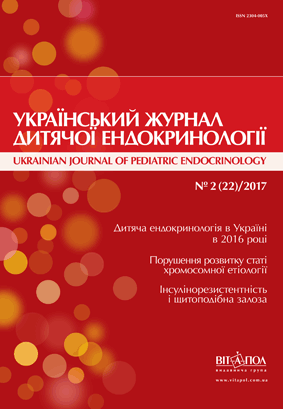Роль йоду й селену у функціонуванні щитоподібної залози
Ключові слова:
щитоподібна залоза, селен, йод, автоімунний тиреоїдит, токсичний зобАнотація
В огляді представлено аналіз літератури з питань впливу мікроелементів на синтез гормонів і функцію щитоподібної залози. Для повноцінної роботи щитоподібної залози однаково важливі такі мікроелементи, як йод і селен, надлишок або брак яких тісно пов’язані з формуванням низки патологічних станів, зокрема автоімунних тиреопатій. Дефіцит селену асоціюється з такими патологічними змінами щитоподібної залози, як збільшення об’єму, зміни ехогенності, виникнення вузлових утворень, призводять до зниження її антиоксидантного захисту. Наведено результати досліджень, які вказують на можливість позитивного впливу препаратів селену на зниження у пацієнтів індивідуального ризику автоімунних процесів.
Посилання
Beckett G.J., Arthur J.R. Selenium and endocrine system // J. Endocrinol. — 2005. — Vol. 184 (3). — P. 455—465.
Bianco A.C., Salvatore D., Gereben B. et al. Biochemistry, cellular and molecular biology, and physiological roles of the iodothyro nine selenodeiodinases // Endocr. Rev. — 2002. — Vol. 23. — P. 38—89.
Bjorkman U., Ekholm R. Hydrogen peroxide degradation and glutathione peroxidase activity in cultures of thyroidal cells // Mol. Cell. Endocr. — 1995. — Vol. 111. — P. 99—107.
Contempre B., Le Moine O., Dumont J.E. Selenium deficiency and thyroid fibrosis. A key role for macrophages and transforming growth factor β (TGFβ) // Mol. Cell. Endocr. — 1996. — Vol. 124. — P. 7—15.
Contempre B., Dumont J.E., Denef J.F., Many M.C. Effects of selenium deficiency on thyroid necrosis, fibrosis and proliferation: a possible role in myxoedematous cretinism // Eur. J. Endocrinol. — 1995. — Vol. 133. — P. 99—109.
Conrad M., Jakupoglu C., Moreno S.G. et al. Essential role for mitochondrial thioredoxin reductase in hematopoiesis, heart development, and heart function // Molec. Cell. Biol. — 2004. — Vol. 24 (21). — P. 9414—23. — Doi:10.1128/MCB.24.21.9414-9423.2004
Derumeaux H., Valeix P., Castetbon K. et al. Association of selenium with thyroid volume and echostructure in 3 to 60year old French adults // Eur. J. Endocr. — 2003. — Vol. 148. — P. 309—315.
Duntas L.H., Mantzou E., Koutras D.A. Effects of a six month treatment with selenomethionine in patients with autoimmune thyroiditis // Eur. J. Endocr. — 2003. — Vol. 148. — P. 389—393.
Duntas LH. Iodine and Selenium in AIT // Horm. Metab. Res. — 2015. — Vol. 47. — P. 721—726.
Ekholm R., Bjorkman U. Glutathione peroxidase degrades intracellular hydrogen peroxide and thereby inhibits intracellular protein iodination in thyroid epithelium // Endocrinol. — 1997. — Vol. 138. — P. 2871—2878.
Farber J.L., Kyle M.E., Coleman J.B. Mechanisms of cell injury by activated oxygen species // Lab. Invest. — 1990. — Vol. 62. — P. 670—679.
Fernando R.F., Chandrasinghe P.C., Pathmeswaran A.A. The prevalence of autoimmune thyroiditis after universal salt iodisation in Sri Lanka // Ceylon. Medical. Journal. — 2012. — Vol. 57 (3). — Р. 116—119.
Gärtner R., Gasnier B.C. Selenium in the treatment of autoimmune thyroiditis // Biofactors. — 2003. — Vol. 19. — Р. 165—170.
Kim H., Park S., Suh J.M. et al. Thyroid-stimulating hormone transcriptionally regulates the thiol-specific antioxidant gene // Cell. Physiol. Biochem. — 2001. — Vol. 11. — P. 247—252.
Kimura T., Okajima F., Sho K. et al. Thyrotropin-induced hydrogen peroxide production in FRTL 5 thyroid cells is mediated notby adenosine 3’,5’monophosphate, but by Ca2+ signalling followed by phospholipase A2 activation and potentiated by an adenosine derivative // Endocrinol. — 1995. — Vol. 136. — P. 116—123.
Koenig R.J. Regulation of type 1 iodothyronine deiodinase in health and disease // Thyroid. — 2005. — Vol. 15. — Р. 835—840.
Köhrle J. The trace element selenium and the thyroid gland // Biochim. — 1999. — Vol. 81. — P. 383—387.
Köhrle J. The deiodinase family: selenlenoenzymes regulating thyroid hormone availability and action // Cell. Mol. Life Sci. — 2000. — Vol. 57. — P. 1853—1863.
Kryukov G.V., Gladyshev V.N. Selenium metabolism in zebrafish: multiplicity of selenoprotein genes and expression of a protein containing 17 selenocysteine residues // Genes. Cells. — 2000. — Vol. 5 (12). — P. 1049—1060. — Doi:10.1046/j.1365-2443.2000.00392.x.
Lacka K., Szeliga A. Significance of selenium in thyroid physiology and pathology // Pol. Merkur. Lekarski. — 2015. — Vol. 38 (228). — P. 348—353.
Leonard J.L., Rosenberg I.N. Thyroxine 5’deiodinase activity of rat kidney. Observations on activation by thiols and inhibition by propylthiouracil // Endocrinol. — 2003. — Vol. 103. — P. 2137—2144.
Levander O.A., Beck M.A. Interacting nutritional and infectious etiologies of Keshan disease: insights from Coxackie virus B induced myocarditis in mice deficient in selenium or vitamin Е // Biol. Trace Elem. Res. — 1997. — Vol. 56. — P. 5—21.
Ma T., Guo J., Wang F. The epidemiology of iodinedeficiency diseases in China // Am. J. Clin. Nutr. — 1993. — Vol. 57. — P. 264S—266S.
Mao J., Pop V.J., Bath S.C. et al. Effect of low-dose selenium on thyroid autoimmunity and thyroid function in UK pregnant women with mild-to-moderate iodine deficiency // Eur. J. Nutr. — 2016. — Vol. 55 (1). — P. 55—61.
Matsui M., Oshima M., Oshima H. et al. Early embryonic lethality caused by targeted disruption of the mouse thioredoxin gene // Dev. Biol. — 1996. — Vol. 178. — P. 179—185.
Mostert V. Selenoprotein P: properties, functions, and regulation // Arch. Biochem. Biophys. — 2000. — Vol. 376 (2). — P. 433—438. — Doi:10.1006/abbi.2000.1735.
Smyth P.P. Role of iodine in antioxidant defence in thyroid and breast disease // Biofact. — 2003. — Vol. 19. — P. 121—130.
Triggiani V., Tafaro E., Giagulli V.A. et al. Role of iodine, selenium and other micronutrients in thyroid function and disorders // Endocr. Metab. Immune. Disord. Drug. Targets. — 2009. — Vol. 9 (3). — Р. 277—294.
Yang W.S., Sri Ramaratnam R., Welsch M.E. et al. Regulation of ferroptotic cancer cell death by GPX4 // Cell. — 2014. — Vol. 156 (1—2). — P. 317—331. — Doi:10.1016/j.cell.2013.12.010. PMC 4076414.
Zois C., Stavrou I., Kalogera C. et al. High Prevalence of Autoimmune Thyroiditis in Schoolchildren After Elimination of Iodine Deficiency in Northwestern Greece // Thyroid. — 2003. — Vol. 13 (5). — Р. 485—489.





